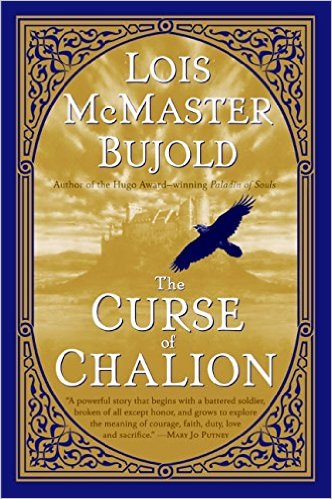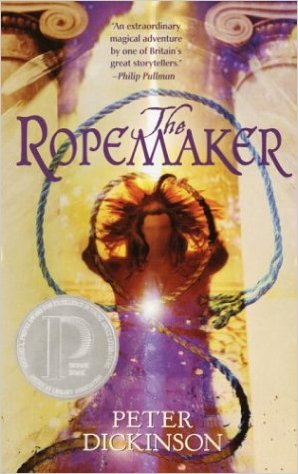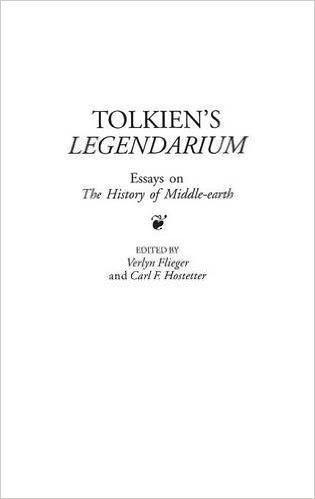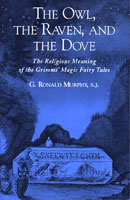Mythopoeic Awards
Acceptance Remarks — 2002
2002 Mythopoeic Fantasy Award for Adult Literature
Lois McMaster Bujold, Author, The Curse of Chalion
The meaning of any literary award is ultimately embodied in the books that have won it. Looking over not only the list of prior winners, but the full list of prior nominees, I am enormously impressed by the good company in which I have so suddenly found myself. Book after book and writer after writer are ones I recognize as still being talked about, argued about, and recommended to each other by readers long, long after the distressingly short sell-by date meted out to novels by today’s market economics.
Co-incidentally, I was recently involved in an on-line discussion of Tolkien, on whose work, in part, this society and its distinguished history are based. I first read The Lord of the Rings in the mid-60’s, when I was 15; I re-read it most recently last winter, at age 52. Some dozen or two re-reads fall in the 37 years between. I can still remember where I was sitting when I first opened up The Two Towers and read, with a pounding heart, “Aragorn sped on up the hill ....” My father’s home office, the air faintly acrid with the scent of his pipe tobacco, in the big black chair under the window, yellow late afternoon winter light shining in through the shredding silver — gray clouds beyond the chill bare Ohio woods to the west. Now, that’s imprinting.
The chair, the room, the man, the world are all gone now. I still have the book. It has stitched itself like a thread through my life from that day to this, read variously, with different perceptions at different ages; today, my over-trained eye even proofreads as it travels over the lines, and sometimes stops to re-arrange a sentence or quibble with a word choice. Is it a perfect book? No, doubtless not. No human thing is. Is it a great book? It is in my heart; it binds time for me, and binds the wounds of time. “And he sang to them ... until their hearts, wounded with sweet words, overflowed, and their joy was like swords, and they passed in thought out to regions where pain and delight flow together and tears are the very wine of blessedness” is no bad epitaph for a writer. I could crawl on my knees through broken glass for the gift of words that pierce like those.
 Thank you all for setting The Curse of Chalion on your shelves next to books that live like this.
Thank you all for setting The Curse of Chalion on your shelves next to books that live like this.And the Lion is exceedingly cool.
2002 Mythopoeic Fantasy Award for Children’s Literature
 Peter Dickinson, Author, The Ropemaker
Peter Dickinson, Author, The RopemakerI am genuinely sorry that I can’t be there to accept my award in person. It isn’t only that I am delighted and honoured to be the recipient, nor that I rather enjoy this kind of conference, especially if I’ve won something. In this case there are more particular reasons.
I donvt propose to favour you with my thoughts on the absorbing (and for me, life-giving) subject of myth. No doubt you have all thought more deeply and carefully about it than I have. Instead, if you will forgive me, I’ll say a few words about my book.
The Ropemaker was a difficult book to write. It began, like all the best myths, in the oral tradition. I composed it, literally, on the hoof, as something to take my wife’s mind off stuff that was troubling her while we were walking our whippets along the byways of Hampshire. Since she is herself a writer of high fantasy I started with an ancient but still potent symbol — unicorns in a dark forest. I had at that point no notion of where the tale would eventually take us, but having started I then had to think what to do with the dratted unicorns.
Effectively the whole story evolved in this manner, with me throwing one traditional element after another into the pot whenever I got stuck, just as a writer of dramatic farce will liven proceedings up from time to time by having a respectable gentleman try to sneak across a crowded room without his pants.
I would not advise this as a method of composition, but despite that my utterly ramshackle tale acquired shape and energies, enough for me to decide to attempt to turn it into a book. This proved, as I say, a seriously difficult task. As you may imagine, reassembling my bricolage of disparate elements into a working mechanism turned out extraordinarily frustrating, but I’m not going to weary you with my own old wearinesses. I found, however, there was an even more fundamental problem. I knew I was telling a very traditional story in a very traditional way using very traditional elements — a magic ring, for heaven’s sake! This was my first attempt at high fantasy. I am not widely read in the genre. How was I to know that everything I thought I was inventing hadn’t in fact been invented again and again and again before me — a footpath tramped into a highway by the feet of previous explorers. The doubt haunted me all through the two years of writing.
I think what rescued me was not any virtue of mine, but the very nature of the material I was working in. A ring is a ring, an object with resonance and meaning, no matter how many fingers it has circled. You know Crabbe’s lines on his mother’s wedding-ring?
This ring so worn, as you behold,So it is with myth, provided you accept it with true imaginative belief. No amount of handling or re-use denatures it. If anything it strengthens it, because its life is in the human imagination, and each fresh manifestation of it generates new believers. I wasn’t setting out, of course, to achieve this — I was simply concerned to tell my story — but I now see that without achieving it my story would have been a dead thing.
So thin, so pale, is yet of gold:
The passion such it was to prove;
Worn with life’s cares, love yet was love.
But even when I’d finished how was I to be sure that I had done so? Despite the excellent reviews I have had, my private doubts lingered. That is why your award is so important to me. The Mythopoeic Society,
 if anybody in the world, can recognise the real thing. For me this award is, as it were, my hall-mark. It authenticates my work. It publicly
declares that I have found gold. Thank you.
if anybody in the world, can recognise the real thing. For me this award is, as it were, my hall-mark. It authenticates my work. It publicly
declares that I have found gold. Thank you.2002 Mythopoeic Scholarship Award for Inklings Studies
Carl F. Hostetter, Editor, Tolkien's Legendarium: Essays on the History of Middle-earth
First, Given the nature of Tolkien’s Legendarium as a book of invited essays from a variety of authors, there should really be a whole pride of lions up here, to acknowledge each of the individual contributions that make the whole a success; namely, the work of Doug Anderson, David Bratman, Marjorie Burns, Joe Christopher, Verlyn Flieger, Chris Gilson, Wayne Hammond, Charles Noad, John Rateliff, Christina Scull, Arden Smith, Paul Thomas, Rayner Unwin, Richard West, Pat Wynne and myself.
In 1996, Ellie Farrell and I were invited to have lunch with Verlyn Flieger, and the talk turned naturally to Tolkien, and in particular to Christopher Tolkien’s monumental presentation of his father’s work in the History of Middle-earth. Noting that the 12th and final volume of that series was approaching publication, we realized that there should be something done not only to mark the achievement of the series (in both senses of the word), but to express both our opinion as to what it meant, and would mean, to Tolkien studies, as well as our profound sense of gratitude to Christopher Tolkien for what he had done both for his father and for all of us who love Tolkien’s works. Being of scholarly and editorial bent, and remembering that Tolkien had himself both participated in one Festschrift (for Charles Williams, in which he gave the world his seminal essay “On Fairy-Stories”), and been the recipient of another (on the occasion of his 70th birthday), I suggested that a Festschrift would be the most appropriate form of recognition. Verlyn enthusiastically agreed, Ellie didn’t tell us we were crazy, essay invitations were sent out, a host of immensely talented authors were mobilized, and after an individually and collectively huge labor of love was finished, Tolkien’s Legendarium was published.
It should come as no surprise that Tolkien’s Legendarium began as a Festschrift honoring both Christopher Tolkien and The History of Middle-earth, for that is transparently what it remained all along, although we were forbidden by our publisher from presenting it as such, apparently because Festschriften do not sell, no matter what their contents. But it was also from the beginning and (we hope) will continue to be a book designed not only to mark an end point, the achievement of The History of Middle-earth, but also a beginning that this achievement, and only this achievement, could bring about: the consideration of the whole of the great work of Tolkien’s heart, his legendarium; of its themes, its growth, its branches, and Tolkien’s most profound thoughts and desires expressed therein, as a whole, as a work of subcreation achieved and viewable not only at certain fixed points in work published during Tolkien’s life, but as a growing and evolving entity through time. It was this purpose, a call to pens, a desire to begin the next, and greater, part of the engagement of scholars and critics with the whole of Tolkien’s work, now permitted by the vast labors of his son, that the epigraph of Tolkien’s Legendarium is meant to convey:
After a time Niggle turned towards the Forest. Not because he was tired of the Tree, but he seemed to have got it all clear in his mind now, and was aware of it, and of its growth, even when he was not looking at it. As he walked away, he discovered an odd thing: the Forest, of course, was a distant Forest, yet he could approach it, even enter it, without its losing that particular charm. He had never before been able to walk into the distance without it turning into mere surroundings. It really added a considerable attraction to walking in the country, because, as you walked, new distances opened out; so that you now had double, treble, and quadruple distances, doubly, trebly, and quadruply enchanting. You could go on and on, and have a whole country in a garden, or in a picture (if you preferred to call it that). You could go on and on, but not perhaps forever. There were the Mountains in the background. They did get nearer, very slowly. They did not seem to belong to the picture, or only as a link to something else, a glimpse through the trees of something different, a further stage: another picture. Niggle walked about, but he was not merely pottering. He was looking round carefully. The Tree was finished, though not finished with — “Just the other way about to what it used to be,” he thought.

2002 Mythopoeic Award for Myth and Fantasy Studies
G Ronald Murphy, S.J., Author, The Owl, the Raven, and the Dove Frodo and Sam, Hansel and Gretel, ich bin geehrt [I am honored].
Frodo and Sam, Hansel and Gretel, ich bin geehrt [I am honored].Thank you to the Mythopoeic Society for honoring me, a very special thanks to Eleanor, thank you to the members of the research award committee and to all who read the book. I cannot tell you how wonderful it feels to do research and then to have your work read by good and appropriate readers — and who could be more appropriate in this case than those who read Tolkien, C.S. Lewis, and Williams. I am grateful that you who are readers of magic and enchantment found my work worthy of inclusion among the books you read.
Reading is entering into an altered state of consciousness. In the case of the brothers Grimm, reading their magic tales is entering into a world of their consciousness, letting onesself be enchanted by their feelings of faith, hope and love. Wilhelm and Jakob Grimm were orphans abandoned early in life by father and mother. The situation of Hansel and Gretel abandoned in the forest is one they knew only too well. The fairy tales do not flinch at expressing fear of the separation caused by death, and they do not flinch from hoping that this separation can be overcome. This for me is the ultimate origin of fairy tale and fantasy literature. You have been told that faith, hope and love are three separate things. They are not. They are like a spectrum, three colors of one light. When faith is faithfulness, fidelity, and is thus combined with love, then faith and love give birth to hope, and hope needs imagination to help it picture what it is hoping for. Think of the Grimms’ Cinderella. The unfaithful father soon forgets his dead wife, but Cinderella does not. Everyday she goes to the grave of her mother and in her faith-love-hope she sees the tree growing up from her mother’s grave. In it the dove settles and showers the gifts of beauty upon her, for indeed her fidelity makes her a beautiful person. When I discovered Wilhelm Grimm’s Greek New Testament in Berlin, I was amazed at how often and with double underlining he singled out the phrase, “I am the good shepherd.” I believe he did this because in the original Greek of the New Testament the phrase reads, “I am the beautiful shepherd,” the word kalos being used for what we translate as ‘good.’ The beautiful shepherd is not one who is handsome, but one who does not run away when the wolf comes — the one who is faithful to his own even in the face of the danger of death. Hansel and Gretel and Cincerella are “beautiful” because they are faithful, loving and have hope, and thus in the language of the fairy tales, they are inheritors of wealth and will one day be back home loved by the father or the prince.
Regardless of whether these blessed feelings occured in ancient Greece, in the Northern Germanic forest, or in Christianity, the feeling of faithful love has always given birth to a hope that the circle can’t be broken. Hope then calls on the imagination to make visible in witches and wolves and hunters, doves and trees, the whole mysterious world of connections, the unseverable loves we hope to keep. Fantasy attempts to see and hear what “the eye has not seen nor ear heard.”
Reading the fairy tales is entering into this altered state of consciousness, an ancient and contemporary state of hopeful consciousness, even in the face of the worst the world and life can offer. It can only do the reader good and make the reader more “beautiful.”
Thank you so much for being readers who appreciate the world of the oldest of human feelings. You cannot imagine, or perhaps you can, how much it means to me to receive an award for my research from readers like you.

Contents copyright 1967- The Mythopoeic Society All rights reserved.